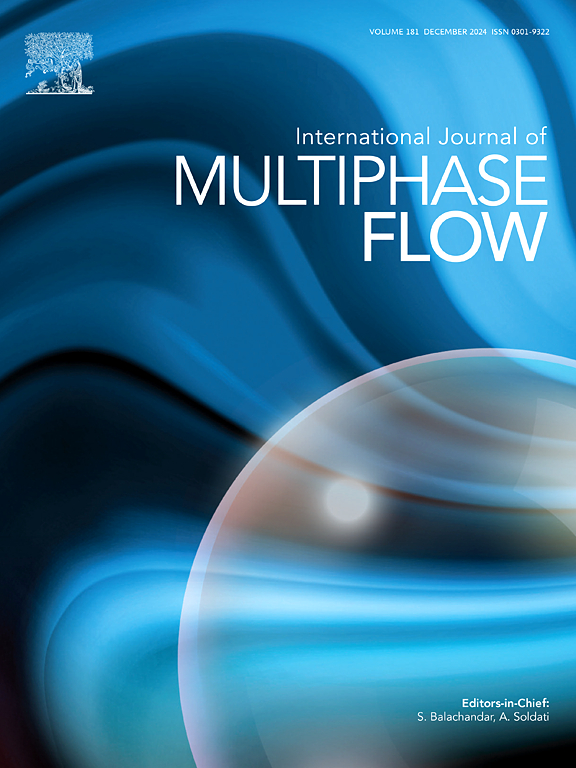Slug-to-churn or churn-to-slug: revisiting the flow patterns transition debate
IF 3.6
2区 工程技术
Q1 MECHANICS
International Journal of Multiphase Flow
Pub Date : 2025-07-01
DOI:10.1016/j.ijmultiphaseflow.2025.105350
引用次数: 0
Abstract
Perhaps one of the most contentious yet long-lasting debates in slug and churn flow literature revolves around the directional nature of the transition between these two flow patterns. Which terminology truly captures its nature—slug-to-churn or churn-to-slug transition? The present study is tackling this debate through an experimental investigation by leveraging high-speed flow visualization and a synergistic combination of advanced signal processing techniques. The analysis is performed for void fraction waves recorded at Z/D = 10, 25, 40, and 60 in an air-water flow along a vertical pipe under gravity-driven conditions at an elevated inlet superficial gas velocity. Visual insights from high-speed imaging conducted at the same spatial positions, combined with statistical analysis and a spatiotemporal-spectral framework incorporating Recurrence Quantification Analysis (RQA), Power Spectral Density (PSD), and Direct and Continuous Wavelet Transforms (DWT and CWT), provided a multidimensional, cross-validated approach—both qualitative and quantitative—to conclusively determine the transition mechanisms and direction. The findings establish churn flow as a spatial precursor to slug flow, unfolding through four distinct regimes: semi-annular, churn, churn-slug transition, and unstable slug flow at Z/D = 10, 25, 40, and 60, correspondingly. The churn-slug transition emerged as a gradual process, wherein diminishing phase interaction-induced instabilities allow slug flow characteristics to take hold. A previously unnoticed mechanism, termed liquid phase penetration, was uncovered as a fundamental driver of churn flow. Propelled by momentum transfer from incoming gas plugs, this mechanism destabilizes leading gas plugs, amplifies huge wave formation, and reinforces flooding dynamics, propagating churning behaviour in upward direction. Its role is pivotal, making its incorporation into slug/churn transition models—especially those based on the entrance effect theory—imperative. Moreover, the study confirmed the exceptional performance (∼99.85 % accuracy) of a novel AI-based diagnostic tool, integrating the CWT framework with a CNN, offering a real-time, scale-independent data-driven solution for axial flow pattern identification (i.e., static instability diagnosis), promising enhanced operational reliability and safety in systems of varying dimensions operating under developing two-phase flow conditions. Nonetheless, this study offers a preliminary contribution, aiming to ignite discussion, encourage future endeavours, and shape the trajectory of future investigations into the slug/churn transition. To solidify the present findings, further experimentation in long pipes and across a broad range of inlet superficial gas velocities is essential.
段塞到搅动或搅动到段塞:重新审视流动模式转换的争论
在段塞流和搅拌流的文献中,最具争议但又持久的争论之一可能是围绕这两种流动模式之间转换的方向性。哪个术语真正地描述了它的本质——段塞到搅动,还是从搅动到段塞的转变?本研究通过利用高速流动可视化和先进信号处理技术的协同组合的实验调查来解决这一争论。在重力驱动条件下,在进口表面气速升高的情况下,沿垂直管道的空气-水流动中,在Z/D = 10、25、40和60处记录了孔隙率波。在相同空间位置进行的高速成像的视觉洞察,结合统计分析和包含递归量化分析(RQA),功率谱密度(PSD)以及直接和连续小波变换(DWT和CWT)的时空光谱框架,提供了一种多维,交叉验证的方法-定性和定量-最终确定过渡机制和方向。研究结果表明,搅碎流是段塞流的空间先导,在Z/D = 10、25、40和60时,搅碎流通过四种不同的状态展开:半环形、搅碎流、搅碎-段塞流过渡和不稳定段塞流。搅拌器-段塞流的转变是一个渐进的过程,其中相相互作用引起的不稳定性的减少使段塞流特性得以保持。一个以前未被注意到的机制,称为液相渗透,被发现是搅拌流的基本驱动因素。在进入气塞的动量传递的推动下,该机制破坏了前置气塞的稳定性,放大了巨大的波浪形成,并加强了驱油动力学,向上传播了搅拌行为。它的作用是至关重要的,因此将其纳入段塞/搅拌过渡模型——特别是基于入口效应理论的模型——势在必行。此外,该研究证实了一种新型基于人工智能的诊断工具的卓越性能(约99.85%的准确率),该工具将CWT框架与CNN集成在一起,为轴向流型识别(即静态不稳定性诊断)提供了实时的、与尺度无关的数据驱动解决方案,有希望在发展中的两相流条件下提高不同维度系统的运行可靠性和安全性。尽管如此,该研究提供了初步的贡献,旨在引发讨论,鼓励未来的努力,并塑造未来对段塞流/流失量转换的研究轨迹。为了巩固目前的发现,在长管道和大范围的入口表面气体速度中进行进一步的实验是必不可少的。
本文章由计算机程序翻译,如有差异,请以英文原文为准。
求助全文
约1分钟内获得全文
求助全文
来源期刊
CiteScore
7.30
自引率
10.50%
发文量
244
审稿时长
4 months
期刊介绍:
The International Journal of Multiphase Flow publishes analytical, numerical and experimental articles of lasting interest. The scope of the journal includes all aspects of mass, momentum and energy exchange phenomena among different phases such as occur in disperse flows, gas–liquid and liquid–liquid flows, flows in porous media, boiling, granular flows and others.
The journal publishes full papers, brief communications and conference announcements.

 求助内容:
求助内容: 应助结果提醒方式:
应助结果提醒方式:


